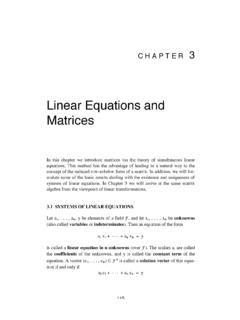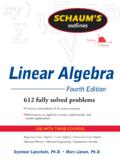Transcription of Projective Transformations - Bilkent University
1 Chapter 7. Projective Transformations Affine Transformations In affine geometry, affine Transformations (translations, rotations, .. ) play a central role; by definition, an affine transformation is an invertible linear map 2 2. A K A K followed by a translation, that is, a map (x, y) 7 (x0 , y 0 ), where x0 = ax + by + c, y 0 = dx + ey + f , and ad bc 6= 0. Note that affine Transformations form a group under composition of maps. Proposition Let P1 , P2 , P3 be non-collinear points in the affine plane. Then there is a unique affine transformation that sends P1 to (0, 0), P2 to (1, 0), and P3 to (0, 1).
2 Proof. We only sketch the proof. Write Pi = (xi , yi ); then we get a linear system of 6 equations in 6 unknowns, and since the Pi are not collinear, the corresponding system has nonzero determinant and thus a unique solution. Projective Transformations Now let us define Projective Transformations . An invertible 3 3-matrix A =. (aij ) M3 (K) acts on the Projective plane P2 K via A([x : y : z]) = [x0 : y 0 : z 0 ], where . a11 a12 a13. (x0 , y 0 , z 0 ) = (x, y, z) a21 a22 a23 . a31 a32 a33. This is well defined, since A([ x : y : z]) = [ x0 : y 0 : z 0 ], so rescaling is harmless.
3 Note that we write A(P ) for the point whose coordinates are computed by pA, where p is a vector (x, y, z) corresponding to P = [x : y : z]. There are, however, matrices in GL3 (K) that have no effect on points in the Projective plane: the diagonal matrix diag( , , ) (this is the matrix with 33. aij = 0 except for a11 = a22 = a33 = ) for nonzero K fixes every [x : y : z] P2 K. The group of all diagonal matrices with entry K . is isomorphic to K , and we can make the Projective general linear group PGL3 (K) = GL3 (K)/K act on the Projective plane. Its elements are 3 3- matrices with nonzero determinant, and two such matrices are considered to be equal if they differ by a nonzero factor K.
4 Some Abstract Nonsense This is a very special case of some fairly general observation. Assume that a group G acts on a set X (this means that there is a map G X X : (g, x) 7 . gx such that 1x = x and g(g 0 x) = (gg 0 )x). For any x X, there is a group Stab(x) = {g G : gx = x}, the stabilizer. Now consider the intersection H of all these stabilizers. Then H is normal in G: in fact, for h H and g G we have (g 1 hg)x = g 1 h(gx) = g 1 gx = x, since h fixes everything (in particular gx), and therefore g 1 hg H. Back to Projective transformation Lemma Let A be a Projective transformation represented by a a nonsin- gular 3 3-matrix A = (aij ).
5 Then the following assertions are equivalent: 1. The restriction of A to A2 = {(x : y : 1) P2 } is an affine transformation ;. 2. a13 = a23 = 0;. 3. A fixes the line z = 0 at infinity. Proof. 1 2: We have [x : y : 1]A = [x0 : y 0 : z 0 ] with z 0 = a13 x + a23 y + a33 . If A induces an affine transformation , then we must have z 0 6= 0 for all x, y K, and this implies a13 = a23 = 0. Note that we automatically have a33 6= 0, since det A 6= 0. Thus we can rescale A to get a33 = 1. Conversely, if a13 = a23 = 0 and a33 = 1, then A([x : y : 1]) = [x0 : y 0 : 1], where x0 = a11 x + a21 y + a31 and y 0 = a12 x + a22 y + a32.
6 This is an affine transformation . 2 3: If a13 = a23 = 0, then A([x : y : 0]) = [x0 : y 0 : 0], hence the line z = 0 is preserved. Conversely, if A([x : y : 0]) = [x0 : y 0 : 0] for all x, y K, then a31 = a32 = 0. This result shows that we have a lot more choice in the Projective world; as an example, we have Proposition Let Pi = [xi : yi : zi ] (i = 1, 2, 3, 4) be four points in the Projective plane, no three of which are collinear. Then there is a unique Projective transformation sending the standard frame, namely [1 : 0 : 0], [0 : 1 : 0], [0 : 0 : 1] and [1 : 1 : 1], to P1 , P2 , P3 and P4 , respectively.
7 34. Proof. The transformation defined by A = (aij ) PGL3 (K) will map [1 : 0 : 0]. to P1 if and only if there is some 1 K with 1 (x1 , y1 , z1 ) = (1, 0, 0)A = (a11 , a12 , a13 ). This determines the first row of A up to some nonzero factor. Similarly, the second and the third rows are determined up to nonzero factors 2 , 3 K . by the second and third condition. Thus the rows of A are given by 1 p1 , 2 p2. and 3 p3 , where the pi are vectors corresponding to the Pi . Now P4 will be the image of [1 : 1 : 1] if and only if 4 p4 = 1 p1 + 2 p2 + 3 p3 (rescaling allows us to assume that 4 = 1).
8 Now this is a linear system of three equations in three unknowns; since the vectors p1 , p2 , p3 are linearly independent, there is a unique solution ( 1 , 2 , 3 ). Since p4 is independent of any two out of p1 , p2 , p3 , the numbers i are all nonzero; this implies that the matrix with rows i pi (i = 1, 2, 3) is invertible, hence A defines a Projective transformation . Finally, A is unique except for the rescaling 4 = 1, hence is unique as an element of PGL3 (K). This result has a number of important corollaries: Corollary Let Pi and Qi (i = 1, 2, 3, 4) denote two sets of four points in the Projective plane such that no three Pi and no three Qi are collinear.
9 Then there is a Projective transformation sending Pi to Qi for i = 1, 2, 3, 4. Proof. Let A denote the Projective transformation that sends the standard frame to the Pi ; let B denote the transformation that does the same with the Qi . Then A B 1 is the Projective transformation we are looking for. Projective Transformations A act on Projective planes and therefore on plane algebraic curves CF : F (X, Y, Z) = 0; the image of C under A is some curve CG : G(U, V, W ) = 0. How can we compute G from F ? Given a point [x : y : z] CF (K), we must have G(A(P )) = 0, and this is accomplished by G = F A 1.
10 Here is an example. Take F (X, Y, Z) = Y Z X 2 and the transformation [u : v : w] = [x : y : z]A = [x + y : y : z]. For getting G, we solve for x, y, z, that is, put [x : y : z] = [u : v : w]A 1 and then plug the result into F : [x : y : z] =. [u v : y : z], hence G(U, V, W ) = F (U V, V, W ) = V W (U V )2 . Thus we get G by evaluating F at (X, Y, Z)A 1 , that is, G = F A 1 . This ensures that a point [x : y : z] on CF will get mapped by A to a point [u : v : w] = [x : y : z]A. on CG . Proposition Projective Transformations preserve the degree of curves. Proof. Projective Transformations map a monomial X i Y i Z k of degree m = i +.








